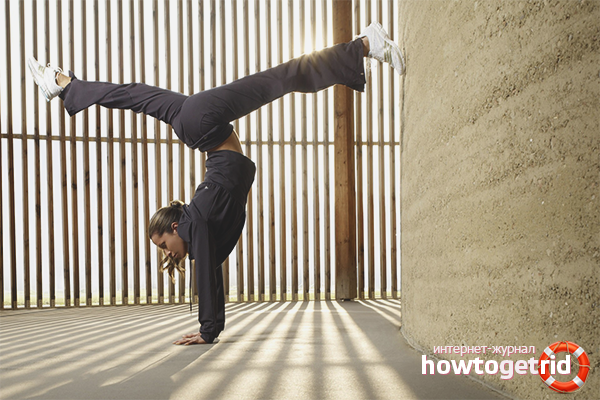The content of the article
In sports, there are many spectacular elements and tricks. They differ not only in the beauty of execution, but also bring great benefits to the body. Handstand is one of these exercises that strengthens and makes strong the muscles of the shoulder girdle, back, abdominals, improves blood circulation in the upper body, teaches you to keep balance, improves the functioning of the vestibular apparatus, relieves the spine.
But before proceeding to a detailed study of the issue, it should be said that this exercise is contraindicated:
- with high intracranial pressure;
- in acute inflammatory diseases;
- with problems with the spine;
- with dislocations, subluxations, bruises of the wrists, elbow and shoulder joints.
It is also worth immediately stopping the exercise if you feel dizzy, worsened, feeling pain. If all of the above does not apply to you, then let's start!
Preparation: Leading Exercises
A handstand is a spectacular trick that even beginners will be able to perform if you have patience. Getting into a position right away will be quite difficult, especially if there is no specific physical fitness. There are a number of leading exercises, the implementation of which will significantly advance you to the goal.
- You should start with exercises that gradually prepare the muscles for the load, this is the well-known inhale-exhale (the body needs oxygen, breathing helps the muscles to tune in to work), warming up the neck, shoulders, arms, belt, legs.
- Keeping your balance in your handstand is not the most important thing. It is important to have strong hands, so you should pay attention to push-ups and various types of straps. When performing these exercises, remember that the body should always be straight, it forms one solid line from the crown to the heels. Fixing the body at the lower point for thirty seconds will help to strengthen the effect during push-ups.
- Bridge - helps to develop the flexibility of the arms, shoulders and back. You can perform it from three positions: lying on the floor, sitting on the floor and from a standing position. Start training with the easy option, gradually moving on until each position becomes familiar and natural for you. Performing the bridge from a standing position, you will already begin to train a sense of balance.
- The next exercise is a stand on the forearms and head. It will be easier to carry out than the original due to greater support on the hands. Nevertheless, it is better to start making such a stand against the wall or with a partner. When you start to feel more confident, you can gradually abandon the support and partner.
- One of the yoga asanas will also help you get closer to your goal. Crow pose helps strengthen the muscles of the shoulder girdle.
- This item is your goal! The regular execution of all preparatory exercises gives you, finally, the opportunity to try a handstand.
If you are now physically ready, another problem of a psychological nature may arise - fear. In fact, fear is normal, because your body has never been upside down. Therefore, you need to lay down sports mats, rugs and not be afraid to fall on them, you can even specially fall several times so that the feeling of fear recedes.
Stand with support
To begin to practice a handstand, you also need to first against the wall or with the help of an insurer. You need to stand at a distance of 25-30 cm from the support, lean forward and put your hands on the floor, shoulder width apart, then push off with your foot and try to straighten the body, stretch your legs along the wall.
You should not stay for the first time in this position for a long time and overload the muscles.It is necessary to increase time gradually, so endurance will train. After a few seconds, push one leg away from the support and return to the starting position. There is a lot of video material on the Internet on this topic, just watch a few times to make everything clear.
Stand without support
Have mastered the handstand with support, now I want to go further? Learning to perform the exercise without outside help.
- We continue to perform a stand near the wall, but now slowly tear off the surface of the leg (alternately), then both and try to maintain balance.
- When this option begins to work out, you need to try to move away from the wall away, but it is still important that it is at a close distance to you.
- The final part is the execution of the exercise in free space, for the first time ask to insure your partner.
- Now that you have completed and achieved your goal, you need to continue to practice the exercise, increasing the execution time.
Do you want to go even further? Walking on your hands! This trick will also be submitted to you, because you already know how to perform the stance.
- You need to start with short and small steps with your hands, remember that you can’t take your hands off the ground at a great distance.
- First, take successive steps: step, pause, return the hand to its original position, etc.
- If you already feel more confident, start walking in circles and increase the distance.
The aerobatics of this exercise is a bar stand. There is no wall, no support, no partner, falling, you can get a serious injury than a normal bruise. Therefore, if you set yourself a new goal, start small, with exercises on the floor bars and gradually you will achieve a result, because once you have already done it!
Video: how to learn to stand on hands











Submit